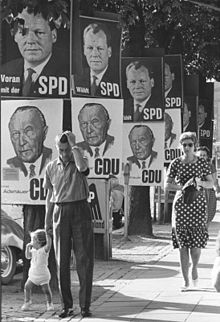Election poster
An election poster is a form of self-promotion and information used by a party during an election campaign , especially with regard to the election date. As a rule, election posters are limited to the image of one or more representatives of the respective party, their logo and a short, concise slogan . Election posters often contain references to additional sources of information for voters (e.g. election events, party website). A distinction can generally be made between large and small area posters.
Large-format posters
Large-format posters are produced by the party's federal or regional association. In election campaigns, large mobile areas that are only set up for the time of the election campaign are used. A tubular steel construction carries the weatherproof plywood panels , which are 2.90 by 3.70 meters . From about six weeks before the election , the partitions will be set up primarily on arterial roads and in large squares.
The posters are usually supplied by the parties and are usually exchanged three to four times per election campaign. After the election, the large mobile areas, of which there are around 28,000, will be stored. Outside of election campaigns, they are also used in the commercial sector.
Small area posters
Small-area posters are often produced by local, district or state associations to address local issues and introduce direct candidates, or nationwide motifs are provided with local slogans, event notices, etc. Ä. glued. Frame posters are also often used. These are posters that are printed with the logos of the parties, but do not yet contain any advertising messages. These empty spaces are then individually filled with local slogans or invitations to election campaign events using stickers.
Disruptor
In Germany, additional stickers (mostly highlighted in color) on the actual posters, which are often attached diagonally in the corners of the poster, are referred to as “ disruptors ”. These stickers disrupt the overall impression visually and thereby draw attention to an additional message. With the interferers, for example, the statement of the poster can be changed again shortly before the election. The interferer also offers the opportunity to react to changes at short notice. Typical statements from interferers are “Vote!” Or “ Both votes for party XY”. In many cases, after the election, a disturber is affixed “Thank you for your trust”, with which the party thanks for the support of its voters.
Shapes and material
Traditionally, election campaign posters are made of paper, which are usually - in A1 or A2 format - glued to hardboard billboards and attached to stakes or - in A0 or A1 format - are glued to poster stands. These poster stands are usually plates with 2 slats as feet or triangular stands, which are composed of three such elements and are set up around lampposts or other posts.
Since the mid-1990s, polypropylene hollow-chamber posters have also been used increasingly . These consist of weatherproof web plates ( cellular sheets ), which can be printed directly, so that no gluing paper posters to the support is no longer required. The printed panels can then be attached to posts with cable ties, for example.
vandalism
Election posters are repeatedly damaged or even removed by third parties. Often you will find doodles that portray the depicted people differently or change the printed slogan of a party. So-called "election poster vandalism" is an increasing phenomenon in election campaigns and counts as damage to property and theft of someone else's property, which can be punished by the police.
Legal
Placing posters in public spaces requires a special permit . The authorization procedure is intended to ensure that the competent authority is informed of the location, duration and scope of the billposting so that it can prevent recognizable disruptions from the outset or keep them within reasonable limits and compensate for the different and sometimes conflicting intentions of road users.
The importance of elections for a democratic state and the parties restrict the authority's discretion in deciding whether parties are allowed to put up election posters so much that, as a rule, a party is entitled to permission. Visual advertising for elections is "one of the tools in the election campaign of political parties today" and has "become an important part of election preparation in today's democracy". Another aspect is the constitutionally required equal opportunities for parties. Selective approval for individual parties is not permitted.
Some municipalities have begun to forbid free billposting and, in return, to provide the parties with space for billposting as shown. These stands will be dismantled outside of the election campaign by the municipality, so that there is no disturbance of the site.
Web links
- Wahlplakate-Archiv.de - Extensive collection of election posters from the Weimar Republic
- Film about exaggerated billposting and the accumulation of election posters


